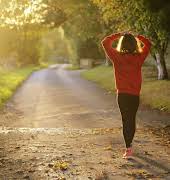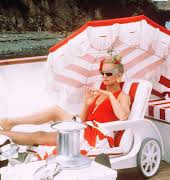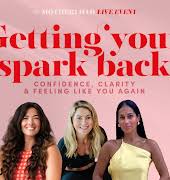
It’s exhausting, it leaves your muscles aching and your lungs sore — yet more and more of us are embracing jogging as our sport of choice. Amanda Cassidy on the joy of running in circles, and why our biology probably has a lot to do with it.
You either love it or hate it. But for years, I just didn’t get it.
The idea of pounding the pavements, trying to suck air in and out as you propel yourself forward while wearing what resembled Spanx seemed, well, a little pointless. What are they running from, I’d jeer philosophically as I drove past, my bottom nestled comfortably in the leather seat of my car.
But those who jog on a regular basis can enjoy a higher life expectancy, a reduced risk of heart disease, protection from chronic disease, better mental health and a lower risk of cancer. Suddenly shin splints didn’t really seem like a strong counter-argument for peeling myself off the couch anymore.
Besides, in the midst of the coronavirus lockdown, it became one of the only options to shake off those anxiety cobwebs.
When I wasn’t blessed by the miracle of “the second breath”, I began to angry jog
And then suddenly, everybody was at it. My Instagram feed became a litany of images of sweaty folk looking delighted with themselves at various finish lines, casually dropping 5k, 10k, 20k of an evening.
How dare they delight in something I just didn’t get. Fine, I sighed. I’ll give it a go. The first week was torture, but I refused to give in, willing those endorphins I’d heard so much about to land on my sweaty head.
I’m an impatient person, so when this failed to materialise, and when I wasn’t blessed by the miracle of “the second breath”, I began to angry jog. I hate this stupid sport, I’d repeat to myself as I resentfully put one foot in front of the other. What. Complete. Bollocks.

Then before I realised what was happening I found myself looking forward to pulling on my best black leggings (we all have them) and angrily pounding the pavements.
The release of energy, letting go of that pent-up aggression that we carry around all day, and the feeling of doing something good for your health, finally clicked. It was my half an hour to tease out any tricky issues I’d encountered during the day, a chance to blast a bit of Beyoncé through the brain, and to enjoy 30 minutes of blissful, albeit exhausting, solitude.
It is also hard to beat that feeling after your shower when you return home red-faced and wispy-haired. Clean, energised, smug.
Personal best
Statistics from the Irish Sports Council show that running is the sport most likely to be taken up by those over the age of 30. Men account for 70% of all those we see jogging in our local parks while women are more likely to take up running for social reasons rather than health benefits.
Many runners go on to obsess over their times – they strive to break the 30 minute 5k and then seek to conquer 10k in under 40 minutes. Good for them.
Naturally, there is something quite seductive about striving towards such fixed goals in our lunatic world– a straight-as-an-arrow, indisputable achievement far from those annoying nuances we often have to juggle in life — ambiguity and perception.
But for others, running is simply an inexpensive way to stay fit.
Hardwired
Running has always been a big part of human nature. Children run continuously, and chasing is a favourite childhood game for a very good reason.
The exhilaration, the physical challenge of avoiding capture and the determination to tag a friend is terrific fun. That joyful out-of-breath feeling reminds us of our youth, what our body is capable of and it appeals to our innate urge to beat the competition.
Born to Run is the best-selling book by Christopher McDougall. He writes about the primitive will to run that us humans have evolved through persistence hunting, aka chasing down the animal so we could eat.
Harvard scientists believe human’s long-distance running ability could even have outrun an antelope (once we can keep them in sight). We have arched feet, Achilles tendons and something called a nuchal ligament in our necks to keep our heads steady as we bob along for miles.

The running revolution
The reason running is currently among the fastest growing forms of exercise is mainly because of how easy it is and how accessible it is to just about anyone, from any background. Unlike our ancestors, exercise is no longer part of our working day, but in addition to it.
As our lives get busier and the demands on our time higher, slotting in 20 minutes to get the heart pumping and increasing fitness needs to be as convenient as possible.
Jogging around our community ticks a lot of those boxes. And then there is the mental health aspect. All exercise contributes to a healthier mind, but in a world where we are never really switched off, jogging might just be the last truly peaceful retreat — a way we can escape into ourselves.
The texts can wait, the 50 thousand questions from the children can be shelved for a bit, and you don’t have to nod awkwardly when you bump into your ex at the gym.
Running is now my therapy. I sometimes like to push myself to go further and faster. Other days it is an achievement just to get my runners on. My four-year-old recently asked me why I was going running and it reminded me of a line from The Catcher in the Rye when Holden Caufield breaks into a run while heading through the school grounds.
“I don’t even know what I was running for — I guess I just felt like it.”
Maybe running from your problems is underrated. Maybe reverting to the most ancient and unadulterated sport really is the most natural thing in the world.
As with many other current trends, there is something quite alluring about going back to the basics; no equipment, no fancy moves — just you and Beyoncé against the world.
Feature Image: Seth Macy, Unsplash
Read more: In defense of the Resting Bitch Face
Read more: How running helped me find self-acceptance
Read more: Ways to fight SAD this winter























